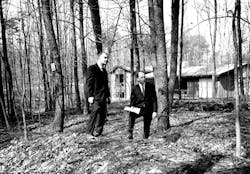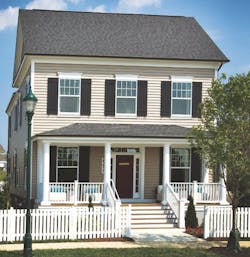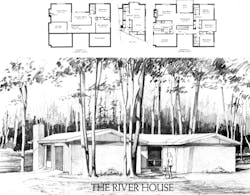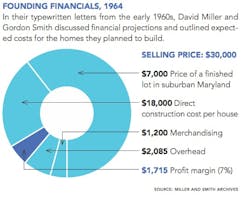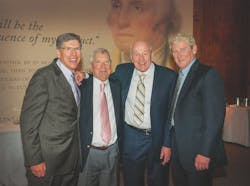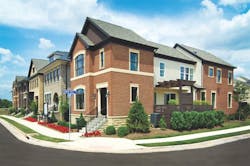Home Building: Enduring Appeal
Long before email, cloud drives, and smartphones, two young Harvard Business School grads sat down at their typewriters and, separated by hundreds of miles, began to craft a plan to transform their graduate school project on the home building industry into reality. With the Washington, D.C., market as their foundation, they researched the existing competition. They scouted land. They persuaded family members to invest. They developed financial projections for “realistic,” “optimistic,” and “pessimistic” scenarios.
And yes, they got a little nervous. “I must admit I left Washington with a great deal of anxiety about the future,” David H. Miller wrote to his Harvard classmate and partner Gordon V. Smith in a letter dated Feb. 19, 1961. “Certainly, a step such as our proposed business cannot be taken lightly.”
But their fears did not stop them from moving forward. “The more I go into this, the fewer doubts I have,” declared an enthusiastic Gordon in a letter dated Aug. 29, 1961, to Miller. “I can hardly wait to get started.”
Gordon V. Smith and David N. Miller. Photo courtesy of Miller and Smith
By 1964, they were ready—and so was their straightforwardly named company, Miller and Smith Construction Corp., backed with $32,000 in cash to build and sell a projected nine homes in the Maryland suburbs. Their office was a makeshift door-turned-desk located in Gordon’s basement, halfway between the furnace and the water heater. They turned to their wives, Helen Smith and Pat Miller, for secretarial services; Helen also decorated the model homes.
Miller and SmithFounded: 1964 by Gordon Smith and David MillerHeadquarters: McLean, Va.Employees: 144Closings: 369 (2013)Gross revenue: $238 million (2013)President: Douglas I. Smith
Fifty years and nearly 17,000 homes later, Miller and Smith has clearly come a long way from its typewritten beginnings. Now headquartered in McLean, Va., the private builder survived the sky-high interest rates of the 1970s, the savings-and-loan crisis of the 1980s, the real estate depression of the 1990s, the housing boom and bust of the 2000s, and the arrival of countless national builders with deeper pockets and lower lending costs. But the firm is more than just a survivor. Miller and Smith has thrived by developing a reputation for creative home designs, land-planning expertise, and a collaborative culture in the Washington metropolitan area, where last year it closed 369 homes and generated $238 million in revenue.
“You should never deviate from what you do best,” says company founder Gordon V. Smith, now 81, his eyes twinkling.
Different by Design
Photo: Jim Kirby Photography
Even as a young home building company, Miller and Smith recognized the importance of land and design. “As I mentioned to you while you were here, I feel the key to building success is good land acquisition and development,” Smith wrote to Miller in the early 1960s. In a separate letter, dated March 8, 1964, Smith practically shuddered on paper as he updated Miller on a parcel they might want to buy and homes he’d seen in the market. “This land backs up to [a park], and there are some small builders active there who are building some horrible stuff that is somehow being sold,” he wrote.
They got one of their first opportunities to differentiate themselves in Fairfax County, Va., where they developed Wessynton in 1967. Created on a 65-acre parcel carved from historic Mount Vernon, the community featured open, contemporary-style homes. “That’s what George Washington would have done,” says Smith, who sealed the land deal with the Mount Vernon Ladies’ Association over tea served from the founding father’s china, and who named the mid-century modern development after Washington’s English ancestors. “Mount Vernon was not a Colonial house. He wanted something contemporary.”
Rendering courtesy of Miller and Smith
Miller and Smith set themselves apart in other ways during those early days as the country wrestled with civil rights and racial equality in the 1960s. While other builders refused to sell homes to black buyers, Miller and Smith welcomed blacks and whites alike, selling its fifth house to a person of color. “It was the right thing to do,” says Gordon, who believes the company’s stand also attracted progressive white buyers who liked the idea of living in a more integrated neighborhood.
As the builder grew, so did its commitment to distinctive designs, frequently inspired by architectural trend-spotting trips around the country. “I didn’t want to be like a national builder that builds a product that appeals to 40 percent of the market,” explains Spencer Stouffer, who joined Miller and Smith in 1975 to handle sales and marketing and later became a partner in the business. “I’m happy to design a product that appeals to only 10 percent of the market because we’ll get a premium price for it.”
Company leaders believe design is one of the factors that has allowed the privately owned Miller and Smith to remain competitive in a market filled with national home builders. “We think they will always have that advantage [of size] on us, so we had to pick something that they can’t emulate,” says Douglas I. Smith, Gordon’s son and company president since 2002.
The approach has brought the company plenty of success—and a few nervous moments. Stouffer still remembers the nail-biting that happened when Miller and Smith’s proposal for Chicago-style brownstone townhomes in Reston, Va., was enthusiastically accepted by the developer. “We were applying to build 50 homes, and they gave us 150,” Stouffer recalls. “It was very scary product—it was urban, which we’d never built before, and it had flat roofs and decks. When we got the pricing on what it would cost to build, I thought, ‘Oh my God, we can’t do it at a price that will give us any profit.’”
He was wrong. “The product took off,” Stouffer says. “It was a home run.”
Collaborative Culture
True Partners: (L to R) Richard North, Spencer Stouffer, Gordon Smith, and Alvin Hall at Miller and Smith’s 50th anniversary celebration. Photo: Max Taylor Photography
Behind Miller and Smith’s innovative designs, though, stands some very old-fashioned values: teamwork, humility, and loyalty. “One reason we succeed is that [Miller and Smith] is not one person,” Doug says. “We are a collaborative ownership group, and it trickles down. People here realize that they are empowered to make decisions, and the most successful people here are those who check their egos at the door.”
It’s been that way at Miller and Smith since the late 1970s, when the builder went through its first leadership transition. After co-founder David Miller left the business for health reasons, Gordon turned to a few trusted colleagues to join him as partners. They included Stouffer, who handled sales and marketing; Richard North, who became the company’s chief financial officer; and construction superintendent Alvin Hall, who had been the company’s very first hire. “That’s when we became a team,” says Hall, who now serves as the company’s CEO.
They admit they are a bit of a motley crew. “If it wasn’t for the business, we wouldn’t be friends because we are that different,” North says. “But we’d do anything for each other.”
The new structure gave Miller and Smith the confidence to tackle increasingly ambitious ventures in the 1980s and beyond. In Fairfax County, Va., the builder took a former gravel pit through one of the largest rezonings in county history, transforming the property into Kingstowne, a 1,300-acre development with office, retail, and 5,800 homes. It purchased a $200 million savings-and-loan bank as a hedge against interest-rate risk and took advantage of the chance in 1988 to invest in restricted Freddie Mac stock, which turned out to be a financial boon. “That helped keep us alive during the 1989-to-1993 recession, which I thought was much worse than 2007 to 2010,” North says.
Photo: Jim Kirby Photography
That era brought other challenges, too, as the partners mulled over the question of succession planning. “Eighty-five percent of family businesses don’t survive past the second generation,” says Gordon, who wasn’t interested in having Miller and Smith acquired by a larger builder. “What do you gain by selling? You’re getting out of the business,” he says. “We like the business.”
1961Gordon V. Smith and David N. Miller discuss starting a home building company.1964Miller and Smith begins full-time operations with $32,000 in cash. David Miller and Gordon Smith agree to pay themselves each $700 every month in salary and no paid vacation for the first year.1967The firm builds a contemporary-style community on 65 acres purchased from the Mount Vernon Ladies’ Association. Miller and Smith names the development Wessynton in a nod to a British version of George Washington’s surname.1970Builders sell a total of 485,000 new homes in the United States.1974Miller and Smith closes 122 homes and generates $22 million in revenue.1981Mortgage rates soar to a national average of 16.63 percent for a 30-year, fixed-rate loan.1984Rezones a former gravel pit and its surrounding land into Kingstowne, a 1,300-acre mixed-use development with retail, office, and 5,800 homes in Fairfax County, Va.1987Purchases Providence Savings and Loan Association.1988Buys stock in Freddie Mac, providing a significant financial cushion for the company.1994Closes 279 homes and generates $63 million in revenue. Sells Providence Savings and Loan Association.2002Doug Smith becomes president of Miller and Smith.2004Closes 384 homes and generates $175 million.2005Sales for new homes peak at 1.283 million in the United States.2011New-home sales plummet to a record low of 306,000.2013Opens One Loudoun, a 358-acre high-density, pedestrian-friendly development with office, retail, and 1,040 homes near a new Metro station in Loudoun County, Va.2014Celebrates 50 years of home building.
Gordon decided to beat the odds instead. “I took it on as a case study,” he says. “How do you pass the business along to the next generation?”
The answer, at least in Miller and Smith, is by proving your value, regardless of your name. “You’ve got to earn it. It’s not a given,” says Doug, who still remembers a long-ago watershed conversation with his father on the subject. Over lunch, Doug, then 18 and a veteran seasonal employee at Miller and Smith, told Gordon that he’d like to join the business. His father’s reply? “‘That’s great, but I don’t want to see you until you are 30 years old,’” recalls Doug, who graduated from college, got an MBA from Harvard, and worked for consumer goods company Procter and Gamble and commercial real estate firm Jones Lang LaSalle before returning to Miller and Smith in 1992 in the warranty department.
Ten years later, Doug became president of Miller and Smith, just in time for the end of the boom and the start of the bust. “It was a baptism by fire,” says Doug, now 51.
But just like his father, Doug’s not going it alone. As the four partners have gradually scaled back their involvement as they approach retirement, they have also been preparing a new generation of partners—Charles Stuart Jr., Jake Oates, Alvin Hall’s son Thomas Hall, and of course Doug—to take their places at the collaborative, design-oriented builder.
As for Doug, he says he can’t wait to see what the next 50 years will bring for Miller and Smith. “Whatever problem is thrown at us, we can figure it out,” he says. PB

